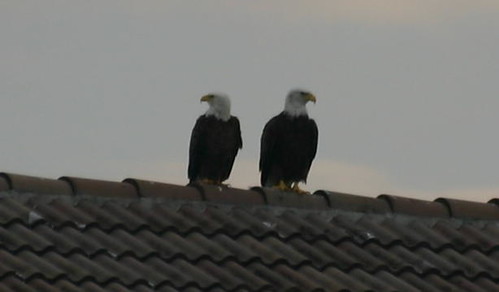In prior years, we occasionally saw Bald Eagles flying over our small Florida lake. Once I saw one attack an Osprey that had just caught a fish. The eagle’s larceny attempt was not successful. However, this year the eagles have paid us several visits (see Double Eagle and The Eagle Has Landed). There is now evidence that they may be breeding within a few miles of us. At least twice, adult Bald Eagles have been observed carrying sticks to a possible nest site. So far, none of my neighbors has seen the actual nest. This morning, during a feeding frenzy that attracted about 5 Ospreys, a couple dozen Ring-billed Gulls, Double-crested Cormorants and several heron species, an eagle suddenly appeared. It flew directly overhead, only about 20 feet high.
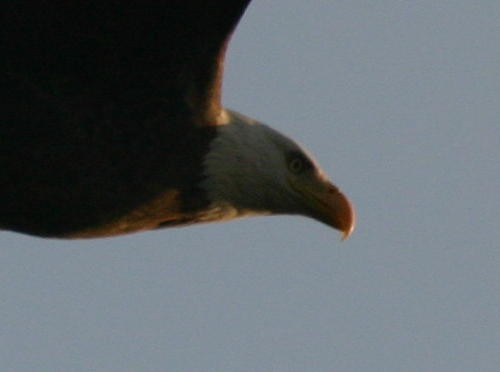
Luckily, I was prepared to photograph it because of a dramatic bird “happening” that made me run for my camera. Just a few minutes earlier, only about 10 feet off our waterfront, an Osprey caught a very large fish and was unable to lift it out of the water. I heard the loud splash and at first, when I looked, I thought I was seeing a cormorant. The “cormorant” morphed into a breast-stroking Osprey. It appeared to be my chance to capture an Osprey’s demise. It actually sunk underwater and was struggling to get the front part of its body and wings up. During the 20 seconds that it took for me to grab the camera and switch to a long lens, the Osprey apparently was able to let go of the fish, as I saw it flying away empty-clawed, vigorously shaking off the water.
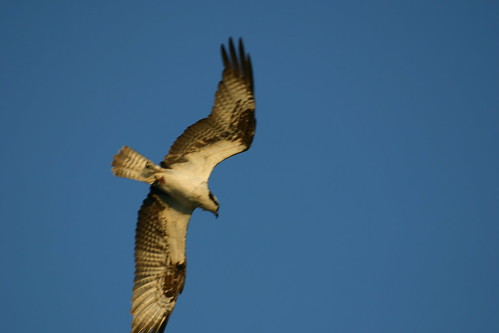
In the harsh early morning backlight, I photographed this Tricolored Heron at our lawn-lake interface. It paid me little heed.

A Little Blue Heron joined the Tricolored. They were attracted by the activity of many small fish along the lake margin, perhaps herded there by a cormorant feeding just offshore.

Then, a Green Heron walked right up, next to the other two herons.
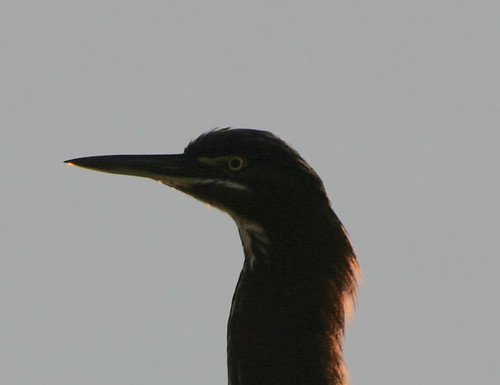
A Ring-billed Gulls, crop full of fish, sat on a nearby rooftop.
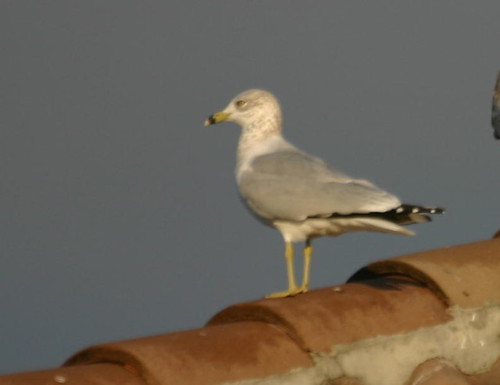
It’s said that South Florida has only two seasons, the hot and wet Hurricane Season and the pleasant and dry Snowbird Season. Actually it is not as boring as that. Much of nature responds to the length of days quite independent of this arbitrary classification. As in temperate climes, spring and fall songbird migration occurs on schedule, and can even be spectacular, between Florida and Cuba (during migration, check the Key West radar link in the column to the left).
The rear of our home faces east, overlooking the lake. As we enter our fourth year of living here, we are already sensitive to the rhythm of the seasons. In summer, the sun rises to our northeast and bears down heavily until noon, when our back patio mercifully begins to gather shade. Blinds are drawn early, and the air conditioning goes into overdrive. Sunrise shifts southward until the first day of winter, when windows stay open day and night. In early March the Giant or Cane toads (Bufo marinus, pictured, from floridagardener.com) anticipate spring with strangely mechanical calls that resemble distant lawn mowers or diesel generators. Soon their black tadpoles crowd the lake margins. The cycle is predictable.

Our 10 acre lake also undergoes cycles, but they seem less predictable. The water is usually clear and tinted like weak tea. Storm runoff may roil it a bit and increase its turbidity for a few days. However, at intervals the lake undergoes a massive transformation. Gobs of green algae suddenly appear on the surface and drift to accumulate on the leeward shores. At the same time, flocks of Ring-billed Gulls, sometimes accompanied by Caspian and Least Terns, suddenly appear. For a few days they participate in a feeding frenzy. After a few days their numbers diminish, and the lake surface is again clear.
This phenomenon, called “turnover,” is caused by the mixing of the lake’s cool and warm layers. I think there were rather subtle turnovers around Thanksgiving the past two years, when cool evenings and gentle fall rain lowered the temperature of the normally warm water near the lake’s surface. As it cools, the density of the upper layer becomes greater than that of the warm water underneath. At some point, the density reaches a critical level and the cool water sinks downward, displacing the warm water that now floats upward, carrying with it the green stuff from the lake bed. The fish that depend upon the vegetation for food and shelter now are distributed more evenly, and become more vulnerable to predators all the way up the food chain.
Up north, and even in our small backyard ponds in New Mexico, turnovers are much more dramatic and predictable, occurring both in spring and fall. Very deep lakes may turnover less frequently as a larger volume of cool water (whether from surface cooling in the fall or spring runoff from snow melt) is required to push up the warm water. Surface action (due to wind-caused waves) in smaller lakes may hasten mixing and “turnover.’
Here in Florida these less dramatic “turnovers” seem to happen at irregular intervals. In late November, following a string of cool nights, with little rain, the lake changed again. This time there was a significant fish kill, mostly Largemouth Bass and Black Tilapia. The water still appears turbid, and sometimes the fish come to the surface, gasping for air. Maybe it is not proper to call this phenomenon a “turnover.” Perhaps the stale lake water is just not being replaced because of the lack of rain. Right now the major source of the water running into our lake seems to be runoff from lawns, full of fertilizers, insecticides and weed-killers. The source of the water is the lake itself—we suck it up directly for our irrigation, and neighbors who do not live on the lakefront get theirs from shallow wells that likely communicate with the surface water.
In any event, here in South Florida I cannot discern as clear a schedule as I have noted in New Mexico, where fall and spring turnovers seemed quite predictable. Whatever the pattern, turnover attracts all the seasonal species of fish-eating birds, from Anhingas and Double-crested Cormorants to Ospreys and herons of many kinds. Wood Storks and Ibises (White and sometimes Glossy) have concentrated on our lake during previous turnovers—and, I’ve caught a few nice fish myself!

This morning, while I was photographing a large-mouthed fish that was gasping for air, a Tricolored Heron took flight and almost ruined my shot.
Maybe we become just too familiar with yard birds to appreciate some of their interesting and unique characteristics.
The long-legged waders that are so common on our Florida lake are a case in point. At first glance they all seem alike, except for size, shape and color, as they appear along the lake shore and go about the business of finding their meals. I’m noticing two right now, at both size extremes of the heron clan, the Green and the Great Blue Herons. Both are standing there, motionless, staring at the water, ready to strike at the first fish that crosses their paths. Both seem to have favorite “fishing holes.”

Most mornings during the winter, at least when kids are not playing around the lake, I can find a Green Heron crouching inconspicuously near the outlet of the storm culvert on our property line. Likewise, the Great Blue has a spot near a waterside bush a few doors away. Both can be as still as statues for many minutes at a time. However, the Great Blue usually stands in several inches of water, while the Green Heron seems not to like getting its feet wet.
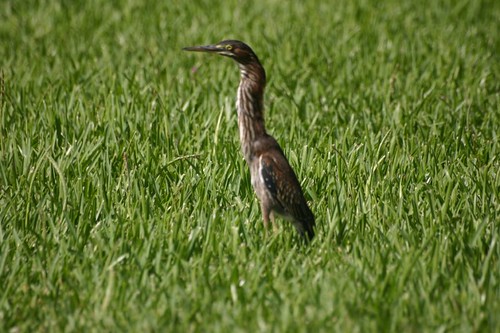
In contrast, the superficially similar Little Blue and Tricolored Herons
are often seen walking along the lake margin. Yet, if our lake were a
racetrack, the Tricolored would probably have lapped the Little Blue several
dozen times before the latter crossed the finish line. Their foraging tactics
differ greatly. The Little Blue seems to spend much of its time enjoying its
reflection, often sitting motionless or stalking furtively with the tip of its
bill in the water, contorting its neck as it moves along. The Tricolored, in its restless fashion, walks back and forth, here and there, striking, probing, wading deeply and then returning to the shoreline, taking short flights, ever changing its mind about where to find the next fish.
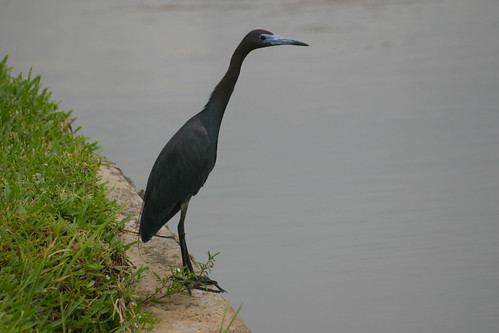
Tricolored Heron:
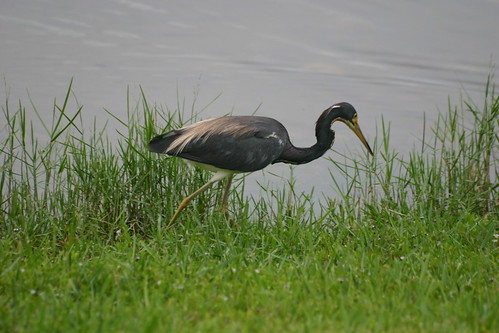
Great Blues and Great Egrets often stalk for reptiles and maybe small birds and mammals in between homes and among lakeside plantings. Though I have never caught one in the act, I suspect they may be the cause of the disappearance of some of our Muscovy ducklings. The hen ducks certainly shepherd their young away from them.
As evidenced by the forward placement of their eyes that permits binocular vision, all of the previously mentioned waders hunt by sight. The White Ibis commonly probes blindly by sweeping its partially open bill from side to side, but also actively grasps prey such as fish, insects, snakes and amphibians. As I have noted [see Trash Birds], this species is very opportunistic, searching our lawn and garbage cans for anything edible. The Wood Stork appears to more consistently catch prey by touch. Its partially open bill clamps down on anything that bumps against it.

I have seen both Wood Storks and herons engage in interesting habits that increase their chances of finding prey. Wood Storks will open and “cup” their wings into an umbrella shape, to shade the water while they probe, presumably to attract small fish into the shadow. They will also stir up the water with their bubble gum-pink feet, to startle the fish and make them blunder into their tactile bills. Tricolored Herons often open their wings briefly and either shade the water to cut down on the glare, or perhaps (as mockingbirds seem to do) to frighten the fish into moving. Snowy Egrets also stir the water with their bright yellow feet, and I have seen Little Blue Herons do the same with their dark feet, though more slowly. Green Herons share this habit, which increases their chances of finding prey.
Herons are usually solitary feeders, though sometimes, around Thanksgiving time (when there seems to be an abundance of smaller fish), we have quite large congregations of Great and Snowy Egrets, [see: Watching the Lake] and have even had ten Great Blues on our small lake. White Ibis (and Glossy Ibis, which sometimes visit) commonly forage in small flocks. Little Blue Herons often join them, possibly attracted by the fish that the ibises find and/or stir up. Presumably for the same reason, Little Blues, Tricolored Herons and both Egret species often follow the Double-crested Cormorants and Anhingas as they dive around the edges of the lake.
The most unusual behaviors I witnessed during the Thanksgiving fish-fest were the Great Blue Heron that swim like a swan in deep water and egrets skimming up fish on the wing, gull-like.
I photographed all of these birds from our back patio.
Maceo, a Chocolate Lab/Doberman mix, was old and failing. After several surgeries and courses of chemotherapy for his extensive mast cell tumors, it was time for him to be sedated and spend his final days with the children. He was there before they came into the family, and he welcomed and protected them.

As usual, he always found a place to rest near them.

Our granddaughters and Maceo were best pals. Now it was their turn to care for him.
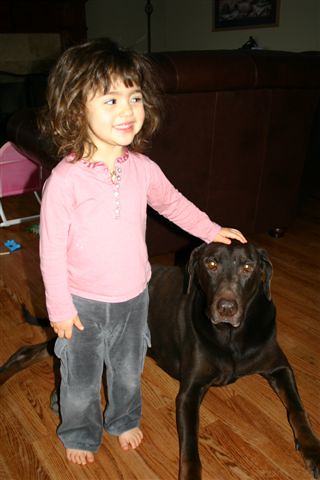
He is so weak and in distress. Nieta covers him up.
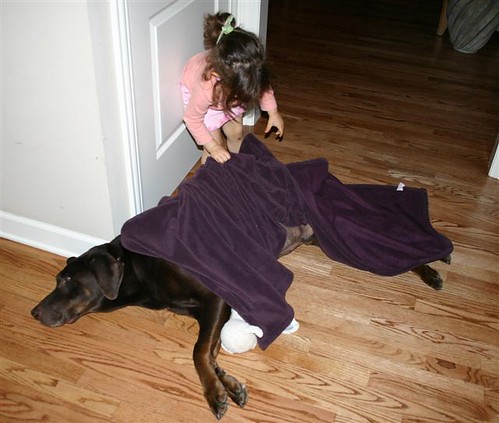
Now he seems to be more comfortable, lying next to her favorite stuffed animal, “Baa.” Only Maceo could separate her from Baa.
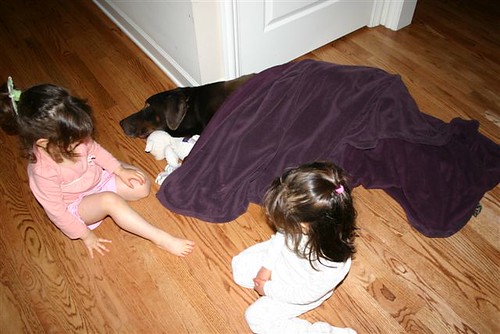
Shh! Maceo is sleeping.

He had to be put down a few days later.
This morning I was processing my e-mail backlog when I heard the distinctive cry of a Bald Eagle. One has been hanging around our small lake for several days now. I was surprised to see two eagles on a rooftop diagonally across the lake from our home, about 200 - 250 yards away. I ran for the camera and took a few pictures, then sat down on the patio to watch them.
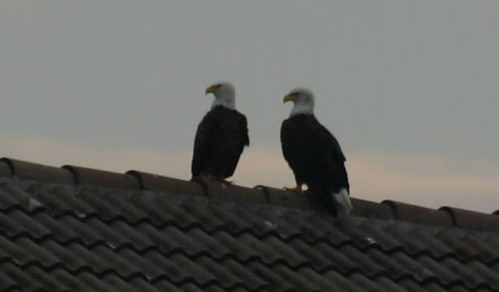
They called to each other periodically, and then the male bird flew up above the female and mounted her..

I got this hand-held picture of them copulating.
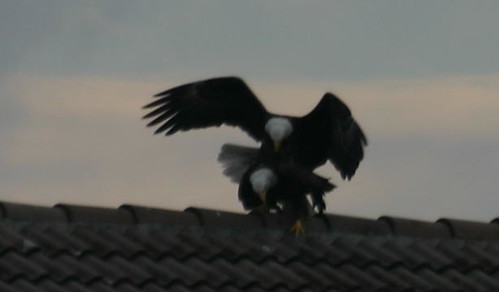
They remained on the roof for about ten more minutes, and then both flew off toward the south. I used a tripod for this post-copulation photo. My camera is a Canon Digital Rebel with 70-300 mm zoom lens.
